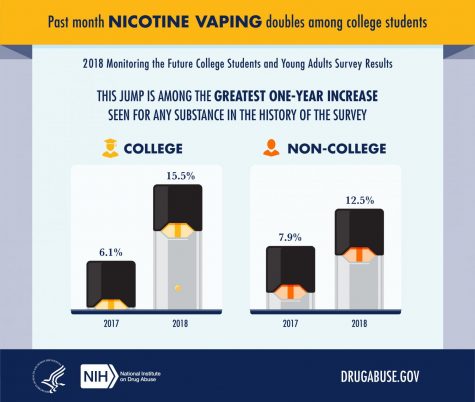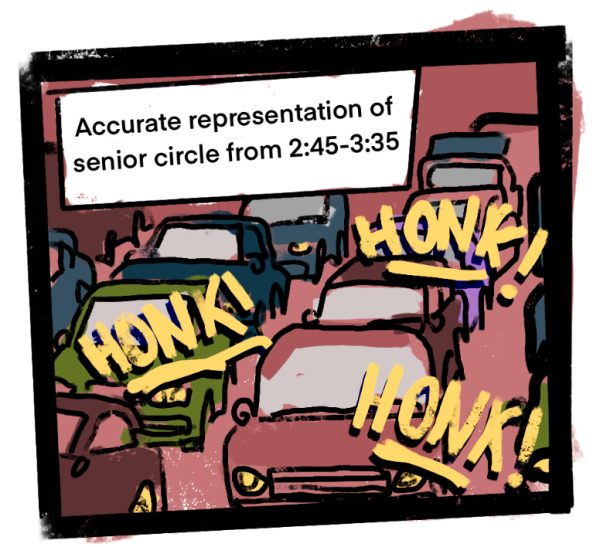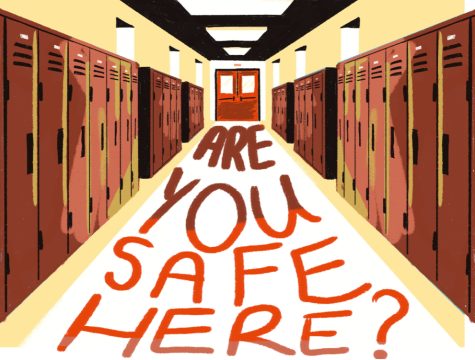The Evolution of Vaping Culture
January 8, 2020

This past summer, the Food and Drug Administration officially classified the use of e-cigarettes — a practice commonly referred to as vaping — as an epidemic. After thousands of people, the majority of which were teens, were hospitalized for vaping related lung illnesses, classifying this as an epidemic is a first step toward solving the problem. Studies conducted by Yale and Duke University have shown that the presence of Vitamin E Acetate in the vanillin flavor of “vape juice”— the fluid within Juuls and other e-cigarettes—is detrimental to health.
In the words of Kate Alderman, Dean of the Class of 2021 and Wellness teacher, “The liquid contains nicotine, which is a highly addictive substance. Nicotine has also been found to cause mood disorders, and it is known to have an effect on the cardiovascular system (heart).” Other deans agree with Alderman. Katie Pepper, Dean of the Class of 2020 stated that “vape use among teens has reached epidemic levels.” But it’s not just the administration that has reached the consensus that vaping is bad for health. This ethos extends to the student body as well. Rafael Cruz, President of the Class of 2022, said “vaping is new enough that we don’t know of the long term effect yet.”
Vaping has had an undeniable impact on the modern teen culture. Pepper explained that this is because “Many people feel it is a safe alternative to smoking cigarettes and other forms of drugs. This is a dangerous misconception.” Students like Egbefe Omonzane ‘23 and Lydia Oluwasola ‘23 agree. Omonzane said “We were moving backwards. We’re watching vaping take over our world and now it’s too late.” Oluwasola said that parents also play an integral role when it comes to condoning vaping. She said “The amount of kids that vape while under the roof of full grown guardians shows how irresponsible we are.”
Despite knowing that vaping is linked to these debilitating biological conditions, people continue to vape. Pepper linked this to “curiosity and/or peer pressure.” This in itself speaks volumes about our culture, one where succumbing to peer pressure is widely accepted despite the repercussions. Cruz agreed, explaining that for most people, “it’s been introduced by friends or older relatives and once someone decides to try it and they like it, they continue to do it.” Oluwasola took it a step further: vaping empowers youth by making them feel mature. She said “there’s a power and/or a feeling of maturity that comes with vaping Just like wearing heels, a Rolex, or any type of sophisticated attire would make a child feel mature, as does vaping.” Omonzane believes “the media has deemed it ‘ok’.” Whether it’s a result of succumbing to peer pressure or parental influence, vaping is, nonetheless, more of an issue for this generation than cigarettes.
The generational crisis of vaping stems from the lack of knowledge surrounding its repercussions. Alderman said “We now have a new generation of young people addicted to nicotine. Young people today are the “guinea pig generation”. We have already seen an outbreak of vaping-related lung diseases, but this is only the beginning.” Students agree. Omonzane said “vaping is making more and more people neglect their health and adults don’t realize how easily kids can get access to them. We are making it ok for little kids to think that vaping and smoking is a good thing to do.” This, according to Oluwasola, leads to a situation where “there are so many people convincing themselves and their families that it’s okay to vape and if it continues this way, the next generation will see vaping as a casual snack in their lunch bags.”
Students and administration alike agree that adequate steps must be taken to prevent the vaping epidemic from worsening. This begins with acknowledging the misconceptions about vaping. Pepper said, “It has become necessary to increase everyone’s awareness about vaping due to the epidemic levels of teen use.” The biggest misconception, according to Omonzane, is that “People think that it’s less harmful than cigarettes when in reality it’s just as bad. You’re filling your lungs with a number of unknown chemicals and slowly but surely, your body is going to break down from it.”
This is made difficult by the marketers themselves. After a Juul representative walked into a ninth grade classroom and declared their products as harmless, vaping has continued to plague this generation. Since then, Juul has faced the law and is forced to include the ingredients on the label. Pepper said, “Vape products are relatively new product on the market so I do think it is a major issue for this generation, especially because products like Juul marketed to, and enticed teens with their flavored Juul pods.” The current vaping epidemic resembles the surge in cigarette smoking seen a few years ago.
Alderman said that “In the same way as cigarette smoking several years ago, vaping has started to become embedded in youth culture. Steps need to be taken now to help curb this dangerous trend among young people.” MBS has taken significant steps to play its part in reducing the harmful effects of vaping. Pepper elaborated on this, “At MBS we have had to think about how to educate the student body about the dangers of vaping. For example, the Wellness curriculum now includes information about the harmful side effects of vaping in both the Upper School and Middle School. Presentations have been made to the faculty and to all new 9th graders about vaping. In addition, vaping is against school policy and MBS has zero tolerance for drugs and alcohol on campus. Students caught vaping will face serious consequences.”
This culture of peer pressure, rebellion, and lack of concern for long term consequences fostered by vaping are more profoundly intimidating. While they are often considered a trademark to teenagers, they are leading to consequences and a mentality which last a lifetime.
















